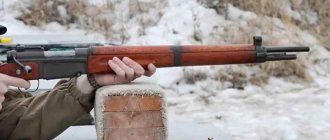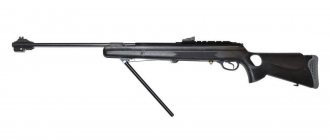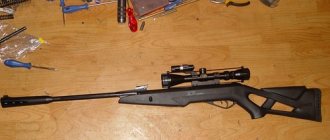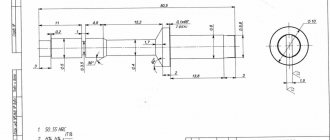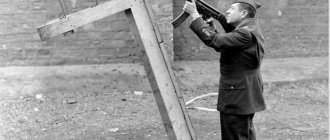| Bushmaster ACR | |
| Type | automatic rifle |
| A country | USA USA |
| Service history | |
| Wars and conflicts |
|
| Production history | |
| Constructor | Magpul Industries[d] |
| Designed by | 2006 |
| Manufacturer | Magpul Industries Corp Bushmaster Firearms International, LLC |
| Options | see options |
| Characteristics | |
| Weight, kg | 3,6–4,4 |
| Length, mm | 909/846/678 with stock extended/retracted/folded |
| Barrel length, mm | 368 (Carbine) 267 (CQB) 457 (SPR) |
| Cartridge | 5.56x45mm NATO 7.62x39mm (AK) 6.8x43mm Remington SPC 6.5x39mm Grendel 7.62x51mm NATO (Magpul Massoud) |
| Caliber, mm | 5.56 7.62 (AK, Magpul Massoud) |
| Work principles | removal of powder gases, rotary bolt |
| Sighting range, m | 500 (effective) |
| Type of ammunition | PMAG sector magazine for 30 rounds (meets STANAG standard) |
| Aim | There is a Picatinny rail for mounting various sights |
| Bushmaster ACR at Wikimedia Commons | |
Magpul Masada
/
Bushmaster ACR
is a small arms complex developed by the American company Bushmaster Firearms International.
Story
This development was initially supposed to modernize the appearance of the M16 family of assault rifles, but Magpul Industries engineers went further and also adopted some design elements from other latest developments, for example, the FN SCAR and XM8. The entire system was developed in just 4 months and was named Magpul Masada ACWS
(English:
A
daptive
C
ombat
W
eapon
S
ystem
- adaptive system of military weapons).
Like the Belgian FN SCAR system, the Magpul Masada complex is modular: by quickly replacing some components, you can change the class of the weapon, that is, the cartridge used and the barrel length. In early 2008, Bushmaster Firearms purchased this system, modernized it and sent it to a series called Bushmaster ACR
(English:
A
daptive
C
ombat
R
ifle
- adaptive combat rifle).
Description
Main modules of the system:
- Upper and lower
receiver - Bolt carrier with bolt,
- USM block with fuse,
- Barrel with gas release mechanism,
- Butt,
- handguard,
- Receiver pad.
The receiver of the machine gun consists of two parts, the so-called receivers
). The upper receiver is made of stamped aluminum, and the lower one is made of high-strength plastic integrally with a pistol grip and magazine receiver. The forend, available in two versions, is also made of plastic. The trigger unit, combined with a fuse, is almost identical to that of the M16. Military weapons are equipped with a trigger that allows firing in single and continuous bursts, while civilian weapons are equipped with a trigger that allows only single bursts of fire. These blocks are interchangeable.
A safety switch for firing modes, a bolt stop button and a magazine release are located on both sides of the weapon. The charging handle can be easily moved from the left to the right if necessary. The bolt and gas system with a three-position gas regulator are similar to those of the AR-180. PMAG magazines that comply with the STANAG standard are made of impact-resistant plastic and are equipped with a window to monitor the consumption of ammunition.
The main difference between the ACR and the Masada is the new location of the charging handle (above the barrel).
What to “feed” Bushmaster?
A target for shooting different types of cartridges from a Bushmaster ACR for accuracy. From top to bottom: 2x5 Geco FMJ 55 grains, 2x5 Mesko FMJ 55 grains (average accuracy 1.5-2 MOA). Below are groups from target cartridges with Berger VLD 70 grain and Sierra Match King 69 grain bullets (average accuracy of about 1 MOA) The main question for any semi-automatic rifle is how “omnivorous” it is, that is, how it copes with all varieties of ammunition of the corresponding caliber that are sold in the civilian market. Therefore, the first thing we did was test this aspect - for which, having loaded one magazine with .223 Rem caliber cartridges produced respectively by TulAmmo, Mesko, Sellier&Bellot, Geco and Black Hills, we headed to the shooting range.
After installing a 10x Nikon optical sight, a Harris bipod and an Ase Utra SL7 sound moderator on the Bushmaster ACR, it turns into a kind of DMR option. Now about personal impressions. The Bushmaster ACR is truly a pleasure to operate: the controls are strategically placed and comfortable, and the bolt handle is exactly where it belongs. When a Magpul PMAG Gen III magazine was emptied, the rifle locked into a bolt stop. Changing the magazine and removing it can now be done in one motion instead of two, as on the AR-15 - and this saves precious fractions of a second during which the shooter is completely unarmed. Some questions arose only about the double-sided safety - it switches too easily, and several times when manipulating the rifle with gloves, it involuntarily turned on during the shooting process. It's worth keeping an eye on this.
Advantages and disadvantages
Advantages
Firstly, the material from which the ACR is made is not just impact-resistant plastic - it is polyamide fibers, from which the body is woven and then covered with a moisture-proof layer of elastic plastic.
The case can withstand temperatures up to +210 degrees without any damage. In cold weather they promise the same high resistance as when heated. Secondly, the quality of processing is very high, there are brand marks and numbers everywhere, and the body itself is rough, which prevents it from slipping in the hands of the shooter.
Excellent ergonomics, the rifle has a good grip, is well weighted, and the controls are easily accessible.
The barrels in the Bushmaster ACR are quick-change, but the main thing is that they are thick-walled, like in sniper versions. It is immediately clear that the structural design of the barrel was developed as a single piece, and later it was simply bored to the required caliber. The inside is chrome-plated, as the manufacturer claims, it is three times thicker than that of the M4, and the barrel will last one and a half times longer.
Flaws
The high price of the weapon, in the basic configuration from $2,700.
Rifle of the XXI century
Bushmaster ACR target from 300 meters (target cartridge with Sierra Match King 69 grain bullet). Accuracy: 1 MOA for 5 shots (0.5 MOA for four shots) When introducing the Bushmaster ACR to Ukrainian shooters, it was called the rifle of the 21st century. How justified is such a pretentious name? Well, firstly, the ACR was actually developed in 2006-2008, so from a factual point of view, this is the development of the new millennium - unlike the M4 or AK. However, the Bushmaster ACR also fully corresponds to the symbolic meaning of the rifle of the new era. This is a compact, high-tech, ergonomic, modular weapon, designed to shoot in any conditions - in dust, dirt, rain, summer heat and winter cold - and with minimal maintenance
And at the same time, what is important, not only shoot, but also consistently hit the target - in any case, the technical accuracy of the weapon allows this. It's up to the shooter!
Options
Magpul Masada system options:
- Carbine - version with a barrel length of 368 mm;
- CQB (eng. C
lose
Q
uarters
B
attle
- close combat) - a variant with a 267 mm barrel and a shortened forend with additional guides; - SPR (English Special
Purpose
Rifle
purpose a
a 457 mm barrel and a PRS sniper butt, adjustable in length and height; - AK - variant chambered for 7.62x39 mm;
- Magpul Massoud is a rifle chambered for 7.62x51mm NATO, introduced in 2008.
Bushmaster ACR system options:
- Standard - the main version with a barrel length of 406 mm;
- Carbine - version with a barrel length of 368 mm;
- CQB - carbine with a barrel length of 318 mm;
- SPR is a sniper version with a 457 mm barrel.
Excerpt describing Bushmaster ACR
30 guns of the Compan division and 8 guns of the Friant and Dessay divisions, a total of 62 guns. The chief of artillery of the 3rd Corps, General Fouche, will place all the howitzers of the 3rd and 8th Corps, 16 in total, on the flanks of the battery, which is assigned to bombard the left fortification, which will total 40 guns against it. General Sorbier must be ready, at the first order, to march with all the howitzers of the Guards artillery against one or another fortification. Continuing the cannonade, Prince Poniatowski will head towards the village, into the forest and bypass the enemy position. General Compan will move through the forest to take possession of the first fortification. Upon entering the battle in this way, orders will be given according to the actions of the enemy. The cannonade on the left flank will begin as soon as the cannonade of the right wing is heard. The riflemen of Moran's division and the Viceroy's division would open heavy fire when they saw the beginning of the attack of the right wing. The Viceroy will take possession of the village [of Borodin] and cross his three bridges, following at the same height with the divisions of Morand and Gerard, which, under his leadership, will head to the redoubt and enter the line with the rest of the army. All this must be done in order (le tout se fera avec ordre et methode), keeping the troops in reserve as much as possible. In the imperial camp, near Mozhaisk, September 6, 1812.” This disposition, written in a very unclear and confused way, if we allow ourselves to regard his orders without religious horror at Napoleon’s genius, contained four points - four orders. None of these orders could be or were carried out. The disposition says, first: that the batteries set up at the place chosen by Napoleon with the Pernetti and Fouche guns aligned with them, a total of one hundred and two guns, open fire and bombard the Russian flashes and redoubts with shells. This could not be done, since the shells from the places appointed by Napoleon did not reach the Russian works, and these one hundred and two guns fired empty until the nearest commander, contrary to Napoleon’s orders, pushed them forward. The second order was that Poniatowski, heading towards the village into the forest, should bypass the left wing of the Russians. This could not be and was not done because Poniatovsky, heading towards the village into the forest, met Tuchkov there blocking his way and could not and did not bypass the Russian position. Third order: General Kompan will move into the forest to take possession of the first fortification. Compan's division did not capture the first fortification, but was repulsed because, leaving the forest, it had to form under grapeshot fire, which Napoleon did not know. Fourth: The Viceroy will take possession of the village (Borodino) and cross his three bridges, following at the same height with the divisions of Maran and Friant (about which it is not said where and when they will move), which, under his leadership, will go to the redoubt and enter the line with other troops. As far as one can understand - if not from the confused period of this, then from those attempts that were made by the Viceroy to carry out the orders given to him - he was supposed to move through Borodino on the left to the redoubt, while the divisions of Moran and Friant were supposed to move simultaneously from the front. All this, as well as other points of disposition, was not and could not be fulfilled. Having passed Borodino, the viceroy was repulsed at Kolocha and could not go further; The divisions of Moran and Friant did not take the redoubt, but were repulsed, and the redoubt was captured by cavalry at the end of the battle (probably an unexpected and unheard of thing for Napoleon). So, none of the orders of the disposition were and could not be executed. But the disposition says that upon entering the battle in this way, orders will be given corresponding to the actions of the enemy, and therefore it would seem that during the battle Napoleon would make all the necessary orders; but this was not and could not be because during the entire battle Napoleon was so far from him that (as it turned out later) the course of the battle could not be known to him and not a single order of his during the battle could be carried out. Many historians say that the Battle of Borodino was not won by the French because Napoleon had a runny nose, that if he had not had a runny nose, his orders before and during the battle would have been even more ingenious, and Russia would have perished, et la face du monde eut ete changee. [and the face of the world would change.] For historians who recognize that Russia was formed by the will of one man - Peter the Great, and France from a republic developed into an empire, and French troops went to Russia by the will of one man - Napoleon, the reasoning is that Russia remained powerful because Napoleon had a big cold on the 26th, such reasoning is inevitably consistent for such historians. If it depended on the will of Napoleon to give or not to give the Battle of Borodino and it depended on his will to make this or that order, then it is obvious that a runny nose, which had an impact on the manifestation of his will, could be the reason for the salvation of Russia and that therefore the valet who forgot to give Napoleon On the 24th, waterproof boots were the savior of Russia. On this path of thought, this conclusion is undoubted - as undoubted as the conclusion that Voltaire made jokingly (without knowing what) when he said that the Night of St. Bartholomew occurred from an upset stomach of Charles IX. But for people who do not allow that Russia was formed by the will of one person - Peter I, and that the French Empire was formed and the war with Russia began by the will of one person - Napoleon, this reasoning not only seems incorrect, unreasonable, but also contrary to the whole essence human. To the question of what constitutes the cause of historical events, another answer seems to be that the course of world events is predetermined from above, depends on the coincidence of all the arbitrariness of the people participating in these events, and that the influence of Napoleons on the course of these events is only external and fictitious.
To clean or not to clean?
As part of an Army competition, the ACR was tested in mud, sand dust, frost and salt fog. The rifle passed all these tests. There is a special conversation about the reliability of the M4, since from the very moment the M16 rifle was put into service, disputes on this issue have not subsided. On the one hand, Stoner’s scheme with the direct removal of powder gases into the receiver places quite high demands on the quality of the cartridges used - more precisely, on the quality of the gunpowder used to equip these cartridges, since low-quality gunpowder produces increased contamination during combustion. On the other hand, the experience of a huge number of owners of civilian AR-15 rifles (that is, shooters who chose weapons consciously and carefully, and not according to the principle “what they gave out in the gun shop is how we fight”) both in America and abroad - many from which they fire exclusively budget and ultra-budget cartridges produced in third world countries - convincingly proves that this system in practice, if inferior in reliability to the notorious Kalashnikov, is only insignificant. Of course, if it is provided with proper and timely service.
Civilian version of Bushmaster ACR Enhanced: partial disassembly
One of the key differences between the ACR and the AR-15 is a short-stroke gas piston instead of a direct gas supply system to the receiver. For anyone who has ever taken a shotgun, pistol or rifle apart for post-fire service, it is quite obvious that a firearm that " you don’t have to clean it,” exists only in the works of science fiction writers. In reality, the more carefully you take care of your weapon, the more reliably it works - and the higher the shooter's confidence in it. In addition, the AR-15 family (and full-size M16 rifles and M4 carbines) are, figuratively speaking, intelligent weapons. Unlike its eternal opponent, the AK, and other models of similar purposes, it is also capable of demonstrating very impressive results in terms of accuracy and shooting accuracy. True, an appropriate approach is required here.
The rifle barrel is removed from its seat in the receiver without any tools. This makes cleaning easier and, if necessary, easier to replace. Cleaning the M4/M16 is a rather tedious task, ideally requiring special tools and accessories, as well as attentiveness and a lot of patience. In order to shoot more and clean less, many shooters install on their rifles (fortunately, the basic design of the AR-15 allows for tuning and upgrading this weapon almost endlessly) so-called Gas Piston, that is, gas exhaust systems based on the use of a short-stroke gas piston . The US Armed Forces decided to do the same thing, purchasing a large number of tuning kits with a gas piston for installation at the stage of upgrading the M4 to the M4A1 version. But a separate competition to replace this weapon was still announced.
100-meter target with impact point shift tests when removing and installing the barrel. Any displacement of the two groups (“before” and “after”) is not noticeable
